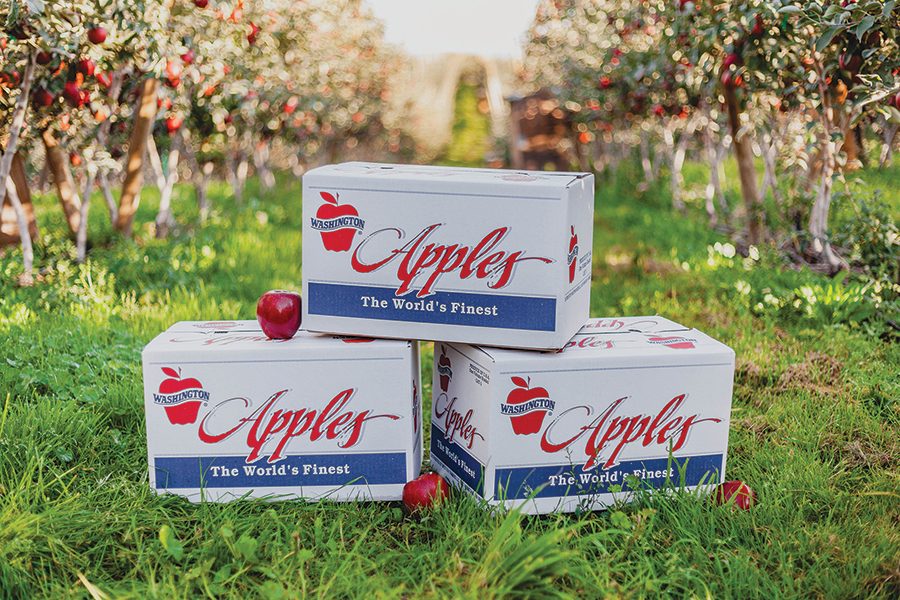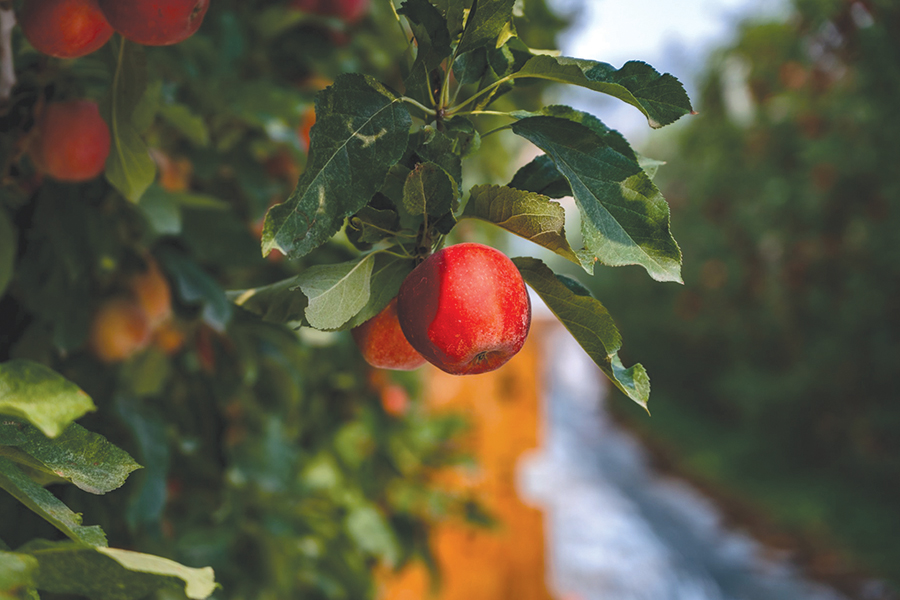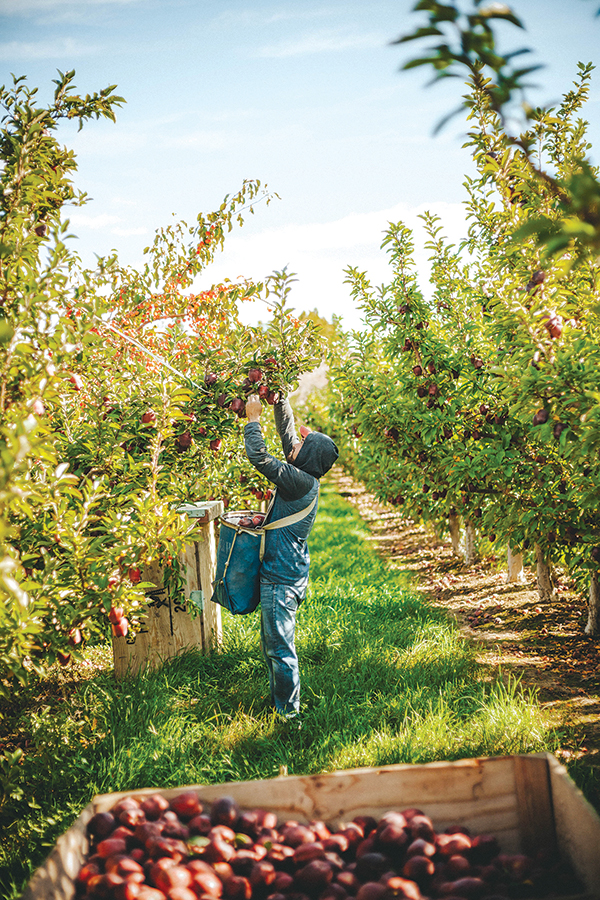
Home » Heat could be biggest threat to apple quality this year
Core issues
Heat could be biggest threat to apple quality this year

June 14, 2024
The 2024 apple season may see a return to normal after the highs and lows of the previous two years — if the weather cooperates.
The 2023 harvest of 137 million bushels, or 40-pound box equivalents, was Washington’s second largest in history, and a 32% increase over the previous year.
That season came on the heels of “one of the smallest crops that we’ve had in a long time at 104 million bushels,” said Todd Fryhover, president of the Washington Apple Commission.
The 2024 apple harvest is still a few months off, but it’s likely to be a bit of a decrease over the previous year.
Since the trees were just beginning to blossom in mid-May, it’s too early to tell for sure how large this year’s crop will be. Fryhover estimated that it could be somewhere between 120 million to 125 million bushels, a more typical amount.
Blooming trees in spring 2024 mean that this year’s crop has already avoided frost, and cooler weather won’t be much of an issue.
Instead, what may affect the apples most is a period of high heat, which could impact the fruit’s quality.
“I think what we need now is just nice, moderate weather,” Fryhover said.
Harvest timing
Apple harvest typically starts in mid- to late-August and continues into November.
When the apples are harvested depends on the variety and elevation, among other factors.
Gala, Golden Delicious and Honeycrisp apples are usually the first to mature in August, but they could ripen as late as September, depending on the weather and elevation.
“If you’re down and you’re close to the river and you’re at 700 feet elevation, the apples are going to mature faster than if you’re at 1,500 feet … up on the side of a mountain,” Fryhover said.
Cripps Pink, better known by the brand name Pink Lady, won’t mature until late October and can be harvested into November.
Growers use this to their advantage when it comes to labor.
By planting multiple varieties of apples, growers can stagger harvest times, meaning that labor can be sustained throughout the season.
“Remember, every apple has a hand that has to pick it off the tree,” Fryhover said.
 Courtesy Washington Apple Commission
Courtesy Washington Apple CommissionNo. 1 industry issue
Growing a variety of apples can help address the consumer need for the best fruit and the producer’s need for maintaining labor.
However, “labor is by far the No. 1 issue in our industry … (both the) lack thereof and cost thereof,” Fryhover said.
According to Fryhover, both Washington’s minimum wage ($16.28 an hour) and the wage rate for the federal H-2A program are some of the highest in the country. Those high labor costs have impacted the industry’s profits for the past several years.
“We rely on the H-2A program because there’s just not enough people out there in the state that really want to work and harvest our apples, our pears, our cherries,” Fryhover said.
The H-2A program allows citizens of other countries to work in temporary agricultural jobs. This year, a new federal regulation will take effect on June 28.
This final rule will help protect H-2A workers, who can apply under its provisions beginning Aug. 29. The regulation’s impact on local growers is not yet clear.
New overtime laws also present difficulties.
Overtime pay for agricultural employees has been phased in since 2022, according to the Washington State Department of Labor & Industries. The final 40-hour threshold was reached in January 2024.
This may not be affordable for some producers.
“If you are going to take a loss to do work, you’re just going to say, ‘Well, I won’t do that work, then,’” said Jon DeVaney, president of the Washington State Tree Fruit Association.
With overtime requirements in place after 40 hours a week, growers may not be able to pay workers after that limit without taking a loss.
That could mean some orchards won’t get harvested, and workers may never get to see that overtime pay.
Smaller crops don’t necessarily help the labor situation either, said Fryhover, because the labor isn’t only harvesting, but pruning and taking care of the trees.
Exports and new varieties
Washington typically exports about 30% of its apples to 60 countries worldwide.
 Courtesy Washington Apple Commission
Courtesy Washington Apple CommissionOf the 70% of apples that remain within the U.S., about 3% remain in Washington. The state produces about two-thirds of all apples in the U.S., but “when you get to this time of the year, we’re 85% to 90% of all the apple availability,” said Fryhover in mid-May.
Mexico and Canada, respectively, lead the international market for Washington apples.
Exporting apples to nearby countries helps take some of the pressure off the industry. Instead of taking over a month to ship, apples can reach Canada and Mexico in a week.
Overseas, Taiwan is a big market, and Vietnam, an up-and-coming market, is particularly interested in new apple varieties.
Washington apples often face retaliatory tariffs abroad, but in India that tariff came down in 2023. The number of apples exported to India expanded from 62,000 bushels in 2022 to over 2 million in 2023, partially due to increased crop size.
China still has several tariffs in place, and it produces about 48% of apples worldwide. However, about 70% of those apples are one variety: Fuji. That means newer varieties, such as the Cosmic Crisp, do well in that market.
The Cosmic Crisp was produced by Washington State University, and Washington growers have exclusive rights to grow the variety for 10 years.
The state’s next new variety will head to market in a few years. A contest was recently held to name WA 64. Submissions closed on May 5.
Jeremy Tamsen, director of innovation and commercialization at WSU’s College of Agricultural, Human and Natural Resource Sciences, said that they received more than 15,000 submissions.
The list will first be narrowed down to 20 contenders, then a final five will go through focus group testing around mid-July.
Tamsen said the name likely will be announced toward the end of August.
WA 64 will be available for planting in 2026, and consumers will begin to see it in grocery stores in 2029.
“The industry has been trending toward these new varieties to align with consumers’ tastes and preferences,” Fryhover said. “It’s an exciting time in the apple industry to provide consumers with multiple opportunities to try different tastes and textures.”
It’s still too early to truly predict what this year’s apple season will look like.
While the pressure of labor costs makes it a “very difficult time to be in the tree fruit industry,” according to Fryhover, growers can look forward to the opportunities presented by new apple varieties and export markets.
Focus Magazine Agriculture + Viticulture
KEYWORDS June 2024
Related Articles





